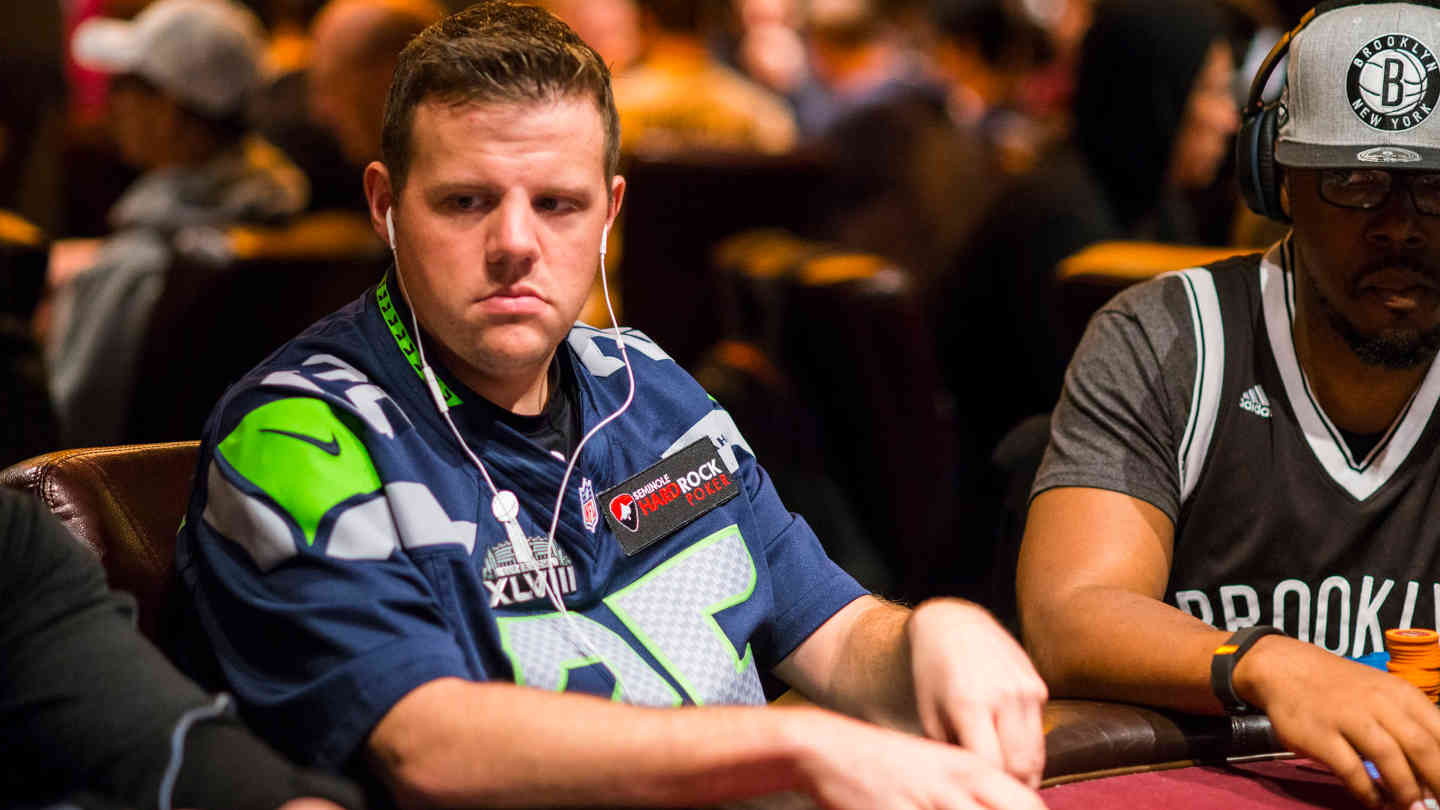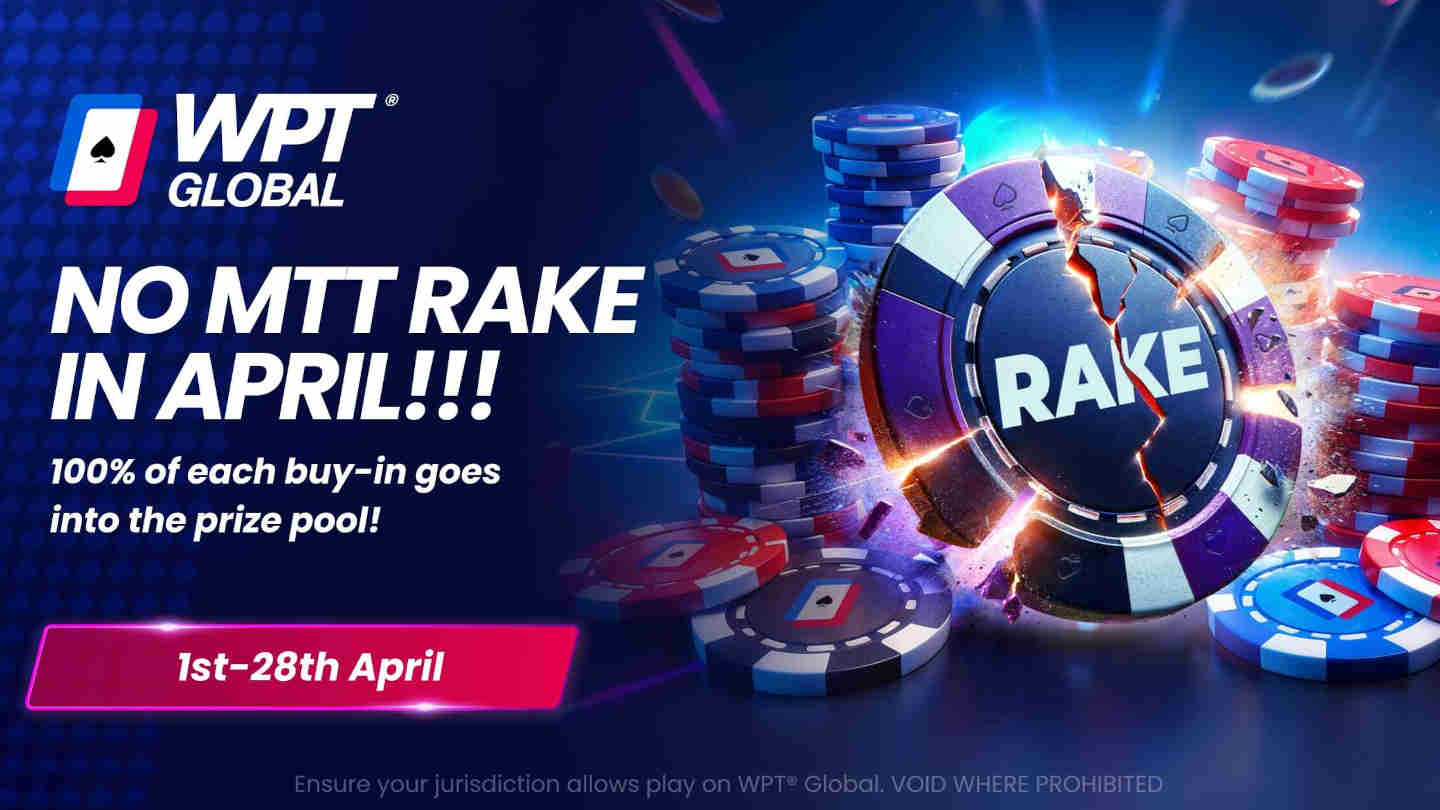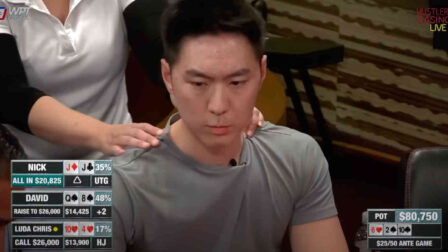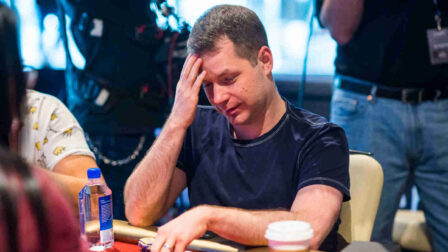ICM Poker: What Is The Independent Chip Model and How To Use It

13 minutes
Last Updated: March 19, 2024
There are many things you need to learn to master the Winning MTT poker tournament strategy, and math is not the last one.
Quite contrary, it is an essential part of any winning strategy, and if you want to stay ahead of your competition, you have to continually improve your game and utilize all the tools at your disposal.
One of those tools is the so-called Independent Chip Model or ICM poker. Essentially, it is an approach for converting tournament or SNG chip stacks to real money equity.
It helps you make precise decisions, which bring positive expected value in the long run. Thus, understanding and learning the ICM poker strategy will quickly pay you dividends, so it is worth spending some time mastering this concept.
Table of content
POKER ICM IN A NUTSHELL
One of the reasons ICM poker was born is the difference between tournaments and cash games. If you play the latter, you know the exact value of your stack all the time. If you have $100 in front of you, that equals $100, as simple as that.
However, that is not the case with your chip stacks in multi-table and SNG tournaments. You have a specific chip stack, and you do not know the exact value of your poker chips unless you make some calculations. This is where the ICM poker strategy comes into play.
The Independent Chip Model is based on two parameters:
- Payout structure (the way prizes are distributed)
- Stack sizes of the players remaining in the tournament
It is a purely mathematical model that does not take into account stuff like skills of the players, position, or table dynamics.
ICM in poker measures the value of your stack size by converting the chips to real money value at any given moment.
It is the reason why many final table deals in tournament poker are based on the Independent Chip Model, or at least that is the starting point of the negotiations.
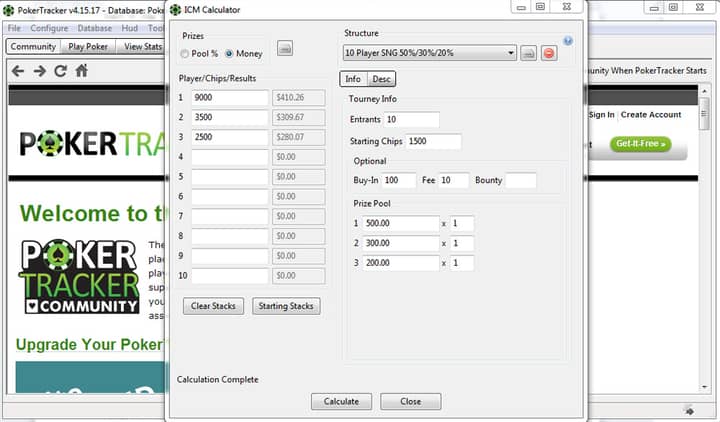
As you can see from this very simple example of a 10-man sit and go with a prize pool of $1000, ICM influence the actual value of the stack.
Although the chip leader has 60% of chips in play, the poker ICM dictates that the value of his stack is just $410 (41% of the total prize pool).
Likewise, the shortest of the three stacks are valued at $280, $80 more than the third-place payout, because he also has a chance to finish higher.
So, if you were ever in a spot where you needed to do an ICM split, you can use a free ICM calculator to get the numbers. But, where do these numbers come from?
HOW DOES ICM POKER STRATEGY WORK?
The best way to understand ICM in poker would be to take a quick look at a simple example.
Let us say three players enter an SNG with a $10 buy-in. There is no rake, so the total prize pool is $30. The winner of the tournament would collect $20, the second place gets $10, and the last place gets nothing.
Before the first hand of the tournament starts, each player has 1,000 chips. At this particular moment, the value of each stack is equal to $10, as all three players have the same chance of finishing first or second based purely on the number of chips they possess.
In the first hand, the UTG player folds, while the other two go all-in. One of the contestants is eliminated, so now we have two players left.
One of them has 2,000 chips, and the other has 1,000. If you use an ICM calculator, you will see how the value of each stack has changed. For example, each of the players is guaranteed to get the second place, which would bring him $10.
Since the player in the chip lead has twice as many chips as his opponent, he is considered two times more likely to win the first place and the last $10 of the prize pool. As a result, using ICM poker calculations, the 2,000 chips of this player have a value of $16.67.
You get this by adding the guaranteed $10 for second place and the 66.7% chance of winning an additional $10 for the first place. By the same logic, the other player’s 1,000 chips are valued at approximately $13.33.
The most important thing to take away from this is that chips you lose are worth more than chips you win.
Let me explain this by continuing our simple example.
If we go to the first hand of the previous example where all players have 1000 chips, which equals $10, you can easily see that if the player loses all chips, his value is $0 because he just busted out and lost his entire stack.
However, the player who won the hand now has 2000 chips, but only $16.67 value of his stack, as we calculated above.
Therefore, you can say that if you go all-in on the first hand and are in a position of a flip, you are risking to lose $10 and can win only $6.67.
It perfectly illustrates this concept and that the value of the chips you hold is bigger compared to the chips you can win.
Thus, you should utilize the advantage of the ICM poker strategy, which can help you learn the right play based on the value of your stack, not just chip count, and that is the winning approach.
How to Use ICM In Poker Tournaments and SNGs
So, poker ICM is not a perfect model you should always follow, but it’s certainly a handy weapon when you play tournaments or SNGs. Especially in the later stages when there aren’t many players left, ICM in poker is a great tool to determine where you stand and what your expectations are.
Since it is too complicated to manually calculate the values of each player in every single situation on the table, we recommend you to use a poker ICM calculator.
There are plenty of free options out there, and some paid features for a more serious study that are part of extra poker software.
You could use the ICM calculator to analyze your play and find some leaks. It is the perfect trainer for short-stack late stages of the tournament where your only option is to shove or fold and can help you build an excellent strategy for the end game.
You can easily do that after sessions and even check some of the spots where you were not sure about the decision. It could help to improve your game and find leaks that might be costing a lot of money in the long run.
ICM Poker Calculation Examples
I will now show you some interesting examples of the Independent Chip Model application and how it might deviate from what you’d expect. By this point, you should have a decent understanding of where these deviations are coming from, but I’ll try to explain it in some more detail.
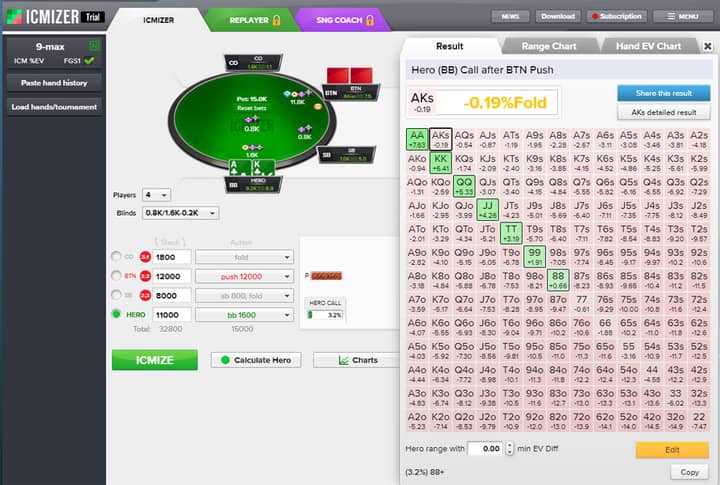
In this scenario, you’re on the bubble of a 9-handed sit and go. The button is showing into you, and you wake up with a very strong hand – AKs.
Your first instinct is probably to snap call it, and you can fully expect to be well ahead of their shoving range, but is it the right move?
However, as you can see, ICMIZER suggests you should fold this hand and a variety of other strong holdings in your range. Why is this the case?
Remember how I talked about how your value in a tournament goes down to zero once you bust out. Well, in this particular spot, the CO player is about to be all-in on the next hand, and they’re likely to bust.
When that happens, you’ll be guaranteed at least the third-place money. If you were to call and lose, you get nothing, and the CO player now gets that third place cash.
You can also see on the graph that the software suggests you call with pocket pairs down to 88 while it is in favor of folding AK and all other strong Aces and broadways.
It is because you’ll have much better odds with a pair like TT against your opponent’s entire showing range, assuming they know what they’re doing.
Namely, in this spot, the button should be shoving very wide exactly because they know you can’t call off easily. Against the shoving range adjusted for that fact, high and mid-high pocket pairs have much higher equity.
ICM Pressure in Poker
One of the things you should always consider when using ICM is the so-called ICM pressure. The idea behind this term is to determine what possible difference a single hand could make to the value of your stack.
For example, when you are close to the bubble, losing a hand and going out of the tournament will cost all of your value. This is where the ICM pressure is at its highest point.
In these spots, you should be looking to take advantage of aggressive play and be shoving yourself, much rather than calling all-ins from your opponents.
This way you put a lot of pressure on other players, and if they know the basics of independent chip model, they will have to fold many hands just because it is mathematically incorrect to take big gambles on the direct bubble or big pay jump by calling, just as I discussed in the previous section.
If you are already in the money and have guaranteed a profit, the ICM pressure is usually much lower. Thus, you should always consider this when making decisions based on poker ICM calculations and time your aggression carefully.
WHAT ARE THE BIGGEST RISKS WHEN YOU USE POKER ICM?
Poker ICM strategy is undoubtedly a useful tool for players, especially when it comes to SNGs. Most of the successful players in this format are using the model and have built a strategy around it. However, that does not mean you should rely solely on the ICM poker strategy.

Of course, this strategy will help you make mathematically correct decisions, but sometimes the table dynamics and style of your opponents could create opportunities to get the tremendous value that is not calculated by the Independent Chip Model.
It could be compared to the GTO poker strategy versus exploitative play. With the first option, you are guaranteed not to lose money, but you can win more if you follow the second one in the right way.
Thus, you are risking to leave some money on the table by blindly following the independent chip model strategy, but you still should know it very well and then compare your options.
One of the biggest risks of sticking to ICM strategy is when you’re playing against opponents who don’t understand ICM. This is often the case in lower buy-in tournaments and SNGs. For this strategy to work, you rely on your opponents to make the correct plays.
It may seem strange, but sticking to ICM against someone who doesn’t understand the model or doesn’t care about it can be a bad idea.
If you go back to the example I discussed earlier, you will see that in that particular spot, the big blind needs to be folding all but the few strongest hands. Thus, the button can shove wide, and there isn’t much you can do about it.
If you want to play correctly, that is.
However, if the player in the big blind is someone who’s just going to call you off with AJ because they believe they’re ahead and disregard everything else, you need to adjust your shoving range.
Pushing 86s, for example, might not work if they’ll look you up with K10+ or some random hand they like.
Of course, this isn’t always easy to figure out as players relying on their “instinct” can always be a wild card. Your best bet is to start with the ICM poker strategy and then make tweaks according to your reads or whatever poker stats you have available on them.
Like with so many other things in poker, nothing is ever set in stone.
ICM Poker Limitations – What It Doesn’t Tell You?
Poker rules are quite complicated, so you should not follow the ICM poker strategy all the time without considering other factors. As I already mentioned, the model does not include a lot of information in the calculations.
ICM does not take into account your skill level
If you have a reason to believe you’re a much better player than your opponents, in reality, your chips have a much higher value than ICM suggests.

The model will not take into consideration the fact that you are more likely than your opponents to put yourself in a position to win.
Of course, as a purely mathematical model, ICM can’t account for these factors. It is you and you alone who need to determine if you have an advantage over the field and make appropriate adjustments.
For example, you don’t want to be risking your tournament life on a flip or even as a slight favorite in a situation where you are likely to win a ton of chips by pure aggression.
By the same token, a lesser skilled player should probably be more willing to take these risks. If a certain play has a neutral or even a slightly negative ICM poker value, but you’re feeling outmatched, you might want to deviate from the baseline strategy.
ICM does not care about table dynamics
What if you’re a short stack with three people left in the tournament and are already in the money. However, the two big stacks clearly don’t care about ICM considerations and are constantly going at it.
In all likelihood, they’ll end up in a huge pot, and one of them will be eliminated, practically gifting you the second-place money.
Of course, in this scenario, you’d want to play tighter than ICM suggests as you are in a situation where it makes sense to wait it out.
Another area where the ICM poker strategy lacks flexibility is that it doesn’t care about table dynamics.
Similarly, if you see that the two big stacks are just not interested in playing against one another and are just waiting for you to bust, you’ll probably want to open up your game.
You’ve reached the point where you have nothing to lose as it is clear that big stacks are aware of the situation and want to protect their equity.
ICM does not evaluate future chips value
Also, poker ICM works on a hand-by-hand basis. It doesn’t account for the future value of the chips.
For example, taking a risk in a huge pot may be a good idea if it significantly increases your chances of winning the tournament even if it isn’t the healthiest play from the purely ICM poker perspective.
For any of these adjustments to work, though, you first need to understand the model and its fundamental premises. When you get the basics down, it will be much easier to figure out the stuff the Independent Chip Model doesn’t tell you and make necessary tweaks.
So ICM poker limitations are as follows:
- It does not take into account your skill level and edge over your opponents
- It has no chance to account for specific table dynamics
- It does not evaluate the future value of chips and works only on hand-by-hand basics
ICM POKER STRATEGY – Something That You Have To Know To Succeed
If you are planning to play tournaments or SNG, you need to master big blind play, c-betting strategies, and much more. However, learning the ICM poker strategy is a must.
Nowadays, games are competent, and you should utilize every weapon you can find. The independent chip model is definitely one of the most powerful ones and should be part of your arsenal.
Also, you should consider joining one of the poker training sites based on your game, and along with the correct poker ICM approach, you will start crushing tournaments sooner than you think. If you are just starting with the games, the Upswing poker lab could be a great place to get the basic knowledge.
- ICM is a valuable model all SNG and MTT players need to understand
- ICM tells you about the cash value of your stack in a tournament
- Learn how to adjust your calling ranges & put pressure on your opponents
- This isn’t a perfect model as it lacks flexibility in some real-life spots
- Sometimes, you’ll need to deviate from ICM to win more or lose fewer chips









